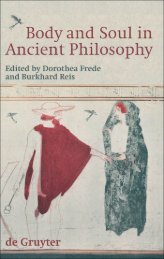Empedocles Redivivus: Poetry and Analogy in Lucretius
Empedocles Redivivus: Poetry and Analogy in Lucretius
Empedocles Redivivus: Poetry and Analogy in Lucretius
You also want an ePaper? Increase the reach of your titles
YUMPU automatically turns print PDFs into web optimized ePapers that Google loves.
Introduction 11<br />
is without them? No, these are the only real th<strong>in</strong>gs, but as they run<br />
through each other they become different objects at different times, yet<br />
they are throughout forever the same.”<br />
As Gale remarks, while the unusual verb adaugescit, mean<strong>in</strong>g “com<strong>in</strong>g <strong>in</strong>to<br />
be<strong>in</strong>g <strong>in</strong> addition” (2.296), corresponds to <strong>Empedocles</strong>’ ἐπιγίγνεται (B17.30),<br />
yet <strong>Lucretius</strong> also refers to <strong>in</strong>tervallis (2.295), criticiz<strong>in</strong>g <strong>Empedocles</strong>’ denial<br />
of the existence of void. 45<br />
It has also been argued that by his reference to <strong>Empedocles</strong>’ reperta,<br />
<strong>Lucretius</strong> may refer to <strong>Empedocles</strong>’ endlessly recurr<strong>in</strong>g cosmic cycle of unification<br />
<strong>and</strong> separation, the alternation <strong>in</strong> power between the cosmic pr<strong>in</strong>ciples<br />
of Love <strong>and</strong> Strife. 46 Trépanier aptly summarizes the version of <strong>Empedocles</strong>’<br />
reconstructed cosmic cycle that I embrace: 47<br />
“Between two opposed, a-cosmic phases, characterized by the complete<br />
dom<strong>in</strong>ation over the elements of Love <strong>and</strong> Strife, there come <strong>in</strong>to be<strong>in</strong>g<br />
two separate worlds, conta<strong>in</strong><strong>in</strong>g mortal creatures, where<strong>in</strong> the two forces vie<br />
for control over the elements. Under the full sway of Love, all the elements<br />
are harmoniously fused together <strong>in</strong>to ‘One,’ also described by <strong>Empedocles</strong><br />
as the Sphairos (fragments 27–9). Strife meanwhile, hav<strong>in</strong>g retreated outside<br />
the elements(?), then reasserts itself by destroy<strong>in</strong>g this unity (fragments<br />
30–1), thereby creat<strong>in</strong>g ‘Many’ <strong>and</strong> cont<strong>in</strong>ues to assert itself until it has<br />
separated the four elements <strong>in</strong>to pure or homogeneous bodies. This is the<br />
reign of Strife. Then once more it is Love’s turn to take the <strong>in</strong>itiative (fragment<br />
35), re<strong>in</strong>troduc<strong>in</strong>g mixture <strong>in</strong>to the cosmos, <strong>and</strong> blend<strong>in</strong>g the elements<br />
<strong>in</strong> ever <strong>in</strong>creas<strong>in</strong>g amounts until it has reconstituted the Sphairos.<br />
Hav<strong>in</strong>g come full circle, the process beg<strong>in</strong>s anew, <strong>and</strong> so on ad <strong>in</strong>f<strong>in</strong>itum.”<br />
Although a thorough discussion of the much vexed question of <strong>Empedocles</strong>’<br />
cycle is out of the scope of this study, 48 attention should be drawn here to<br />
Graham’s important observation regard<strong>in</strong>g <strong>Empedocles</strong>’ style. Accord<strong>in</strong>g<br />
to Graham, when <strong>Empedocles</strong> discusses the recurrence of the cycle, he systematically<br />
repeats a specific AB motif, which corresponds to the dipoles of<br />
unification <strong>and</strong> separation, the one <strong>and</strong> the many, Love <strong>and</strong> Strife, while<br />
he makes variations <strong>in</strong> his phras<strong>in</strong>g <strong>and</strong> sentence structure; <strong>in</strong> this way,<br />
<strong>Empedocles</strong> employs a “mimetic structure” <strong>in</strong> order to reflect the image of<br />
the world he describes. 49<br />
As far as <strong>Lucretius</strong> is concerned, his poem is beyond any doubt permeated<br />
by images of the eternal cycle of growth <strong>and</strong> decay. In the first <strong>in</strong>stance,<br />
<strong>Lucretius</strong>’ evocation of Aphrodite, who reigns over creation <strong>in</strong> the proem, is






![[Niall_Livingstone]_A_Commentary_on_Isocrates'_Busiris](https://img.yumpu.com/51449110/1/163x260/niall-livingstone-a-commentary-on-isocrates-busiris.jpg?quality=85)

![[Richard_Sorabji]_Self__Ancient_and_Modern_Insigh(BookFi.org)](https://img.yumpu.com/30857691/1/174x260/richard-sorabji-self-ancient-and-modern-insighbookfiorg.jpg?quality=85)




